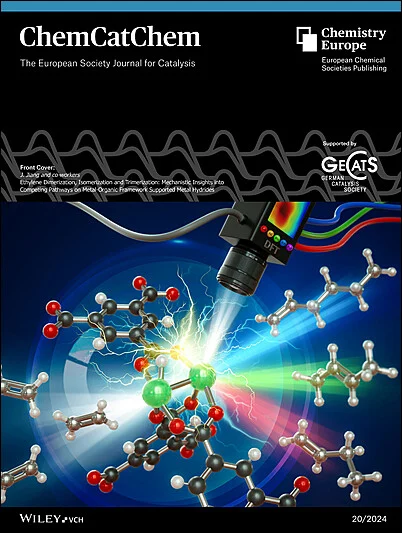Oxidase‐like nanozyme activity of ultrathin copper metal‐organic framework nanosheets with high specificity for catechol oxidation
IF 3.8
3区 化学
Q2 CHEMISTRY, PHYSICAL
引用次数: 0
Abstract
In nature, catechol oxidase catalyzes the oxidation of o‐diphenol to o‐quinone to produce a series of highly important polyphenolic natural products. Although mimicking the functionality of natural enzyme using a nanozyme was found to be beneficial, attaining a high specificity is challenging. Herein, we have explored the thickness‐dependent oxidase activity and specificity of Cu‐metal‐organic framework (MOF) nanosheets. The unique synthetic method offers control over the thickness of the Cu‐MOF nanosheets. The ultrathin (4 nm) Cu‐MOF (Cu‐UMOF) nanosheets as an oxidase nanozyme exhibit high specificity for catechol oxidation without having any peroxidase activity. Interestingly, the specificity is lost for the thicker (20‐30 nm) Cu‐MOF nanosheets. The binuclear Cu‐center, coordinative and electronic unsaturation tuned electronic structure in Cu‐UMOF, resulting in higher specificity for catechol oxidation than thicker Cu‐MOF.对儿茶酚氧化具有高度特异性的超薄金属有机框架铜纳米片的类氧化酶活性
在自然界中,儿茶酚氧化酶催化邻二苯酚氧化为邻醌,从而产生一系列非常重要的多酚天然产物。虽然利用纳米酶模仿天然酶的功能被认为是有益的,但要达到高特异性却是一项挑战。在此,我们探索了铜-金属-有机框架(MOF)纳米片的氧化酶活性和特异性的厚度依赖性。独特的合成方法可控制 Cu-MOF 纳米片的厚度。作为氧化酶纳米酶的超薄(4 nm)Cu-MOF(Cu-UMOF)纳米片对儿茶酚氧化具有高度特异性,而不具有任何过氧化物酶活性。有趣的是,较厚(20-30 nm)的 Cu-MOF 纳米片失去了这种特异性。双核 Cu 中心、配位和电子不饱和调整了 Cu-UMOF 的电子结构,从而使其儿茶酚氧化特异性高于较厚的 Cu-MOF。
本文章由计算机程序翻译,如有差异,请以英文原文为准。
求助全文
约1分钟内获得全文
求助全文
来源期刊

ChemCatChem
化学-物理化学
CiteScore
8.10
自引率
4.40%
发文量
511
审稿时长
1.3 months
期刊介绍:
With an impact factor of 4.495 (2018), ChemCatChem is one of the premier journals in the field of catalysis. The journal provides primary research papers and critical secondary information on heterogeneous, homogeneous and bio- and nanocatalysis. The journal is well placed to strengthen cross-communication within between these communities. Its authors and readers come from academia, the chemical industry, and government laboratories across the world. It is published on behalf of Chemistry Europe, an association of 16 European chemical societies, and is supported by the German Catalysis Society.
 求助内容:
求助内容: 应助结果提醒方式:
应助结果提醒方式:


